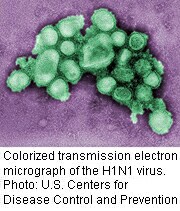
FRIDAY, Aug. 13 (HealthDay News) — Despite the current lull in H1N1 influenza activity, experts say it’s likely that the Northern Hemisphere will see a new, but still mild, wave of the virus this flu season.
The virus will continue to circulate, said Dr. Scott Lillibridge, executive director of the National Center for Emergency Medical Preparedness and Response, but he hasn’t “seen anything to suggest it’s going to come back bigger or worse.”
Others agreed.
“A conservative view would be that we will see a predominance of H1N1 [as opposed to other strains] this year, that the size of the outbreak will be a little smaller than last year, that the viruses will have some changes in it — some mutations — and that it will not be particularly worse than it was last year,” said Dr. Edward Walsh, a professor of infectious diseases at the University of Rochester Medical Center in Rochester, N.Y.
As to when it might appear, “maybe towards a more normal winter, meaning peaking in January rather than in October, moving towards its usual seasonal time,” Walsh said.
The H1N1 “swine” flu first appeared in Mexico in 2009, surprising everyone with its various quirks. Notably, this flu started infecting people in the spring as opposed to the normal fall/winter pattern of the “regular” flu.
H1N1 also primarily affected younger people and caused relatively mild illness, except in pregnant women, obese people and those who already had vulnerable immune systems.
After peaking last October, the virus has kept a low profile, except for an uptick in the number of cases in several southeastern states this spring.
According to the U.S. Centers for Disease Control and Prevention, the public health emergency first declared in the United States in 2009 “expired” on June 23. Just this week, the World Health Organization officially noted that the 2009 worldwide pandemic was over.
H1N1 is likely lurking in some animal reservoir right now. “It’s probably in an animal host that is not pathogenic to the animal,” said Dr. Len Horovitz, a pulmonary specialist with Lenox Hill Hospital in New York City.
In recent weeks, outbreaks of a different strain of influenza — H3N2 — have been spotted in Iowa.
And it’s possible that will be a dominant strain this year. The Southern Hemisphere, which is wintering right now, is seeing a mixture of H1N1 and H3N2, Walsh said.
“We might see very little H1N1 and more H3N2 or Influenza B, although I think the chances of that should be significantly less than [a season dominated by H1N1],” he noted.
With H1N1, there’s a good possibility that much of the U.S. population will be immune, either because they were sick last year or because they received the vaccine, Walsh added.
The flu is notorious for mutating each year, however.
“Very often, let’s say if two . . . flu viruses are in the same host and they do a reassortment of genetic material where they sort of exchange genetic material and therefore genetic character, it’s possible that H1N1 will take on more virulence,” Horovitz said.
Still, “we can’t predict if H1N1 will evolve in such a way that it circumvents the immunity that has developed and also cause a big outbreak,” Walsh cautioned.
More information
The U.S. Centers for Disease Control and Prevention has more on H1N1.

